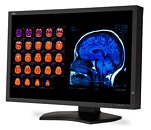Monday, November 26th 2012

NEC MultiSync MD Series Refreshed with MD211C2 and MD211C3
NEC Display Solutions of America, a leading provider of commercial LCD display and projector solutions, announced today the MultiSync MD211C2 and MD211C3 medical-grade displays for diagnostic imaging in healthcare organizations. The MD211C2 and MD211C3 are on display at Radiological Society of North America's 2012 Expo (Booth No. 7520) today through November 29 at the McCormick Place in Chicago.
These 2- and 3-megapixel medical diagnostic displays are designed to meet the needs of healthcare facilities requiring consistent and accurate medical imaging using Picture Archiving and Communication System (PACS). MultiSync MD Series models are factory calibrated to the DICOM grayscale function for luminance and include a new, smaller front sensor to maintain a calibrated brightness as well as an ambient light sensor that automatically adjusts the display's brightness based on existing lighting conditions. The all-digital connectors, including DisplayPort and a new two-port USB hub, enable advanced connectivity for any type of workstation."We're excited to showcase these new monitors at RSNA 2012 in workstations that will include dual medical imaging monitors accompanied by a professional-grade referral monitor," said Art Marshall, Product Manager of Professional and Medical Displays at NEC Display Solutions. "NEC's goal is to increase productivity for healthcare professionals and improve their overall total cost of ownership."
The MD211C2 and MD211C3 include:
These 2- and 3-megapixel medical diagnostic displays are designed to meet the needs of healthcare facilities requiring consistent and accurate medical imaging using Picture Archiving and Communication System (PACS). MultiSync MD Series models are factory calibrated to the DICOM grayscale function for luminance and include a new, smaller front sensor to maintain a calibrated brightness as well as an ambient light sensor that automatically adjusts the display's brightness based on existing lighting conditions. The all-digital connectors, including DisplayPort and a new two-port USB hub, enable advanced connectivity for any type of workstation."We're excited to showcase these new monitors at RSNA 2012 in workstations that will include dual medical imaging monitors accompanied by a professional-grade referral monitor," said Art Marshall, Product Manager of Professional and Medical Displays at NEC Display Solutions. "NEC's goal is to increase productivity for healthcare professionals and improve their overall total cost of ownership."
The MD211C2 and MD211C3 include:
- 21.3-inch IPS panel with wide viewing angles
- 2- and 3-megapixel resolutions, respectively
- Factory calibrations to the DICOM grayscale function for luminance
- 1600 x 1200 and 2048 x 1536 native resolution, respectively
- 900 and 800 cd/m² brightness, respectively (both are 400 cd/m² calibrated)
- Digital uniformity correction reduces screen uniformity errors and compensates for differences in grayscale and luminance across the entire screen
- 70 percent smaller front sensor constantly monitors calibration and corrects for fluctuations of light output and color, maintaining the factory calibration throughout the life of the monitor
- GammaCompMD QA software for worry-free calibration and conformance testing to the DICOM standard
- 14-bit internal lookup table (LUT) provides for more finely detailed, high-definition rendering of color images and crisper display of even the most delicate shadings
- DVI-D and DisplayPort inputs and USB hub (one up, two down)
- 150mm height adjustability in landscape orientation (103mm in portrait), as well as pivot, tilt and swivel
- Restriction on Hazardous Substances (RoHS) compliant
- Five-year limited warranty with Advanced Overnight Exchange

6 Comments on NEC MultiSync MD Series Refreshed with MD211C2 and MD211C3
And whenever a company mentions "total cost of ownership" that mean... EXPENSIVE
When it comes to displays I know LCD/TFT has had a long way to go to even match the quality of high end CRT monitors. I don't see retina displays in the original article... why is it even being mentioned in this thread? The pixel pitch would have to be impressive given the size and resolution advertised. That is impressive in a gimmicky sort of way, although I don't see the usefulness of "retina" quality displays over the usefulness of high resolution displays in the medical field. They are both high resolution, but the point I'm making is that they are marketing the resolution and not the "retina"-ish aspect of the screen. They just need to view detailed scans of patients and not marvel at the crispness of the fonts on their screen.
Kudos to NEC for continuing to advance the market.